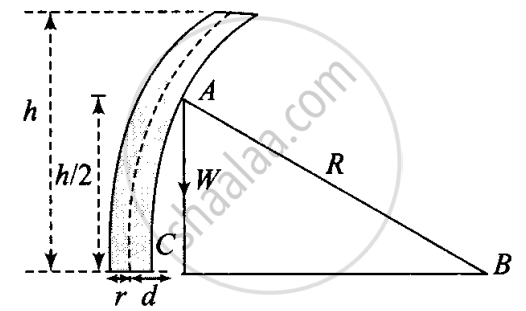Advertisements
Advertisements
Question
In nature, the failure of structural members usually result from large torque because of twisting or bending rather than due to tensile or compressive strains. This process of structural breakdown is called buckling and in cases of tall cylindrical structures like trees, the torque is caused by its own weight bending the structure. Thus the vertical through the centre of gravity does not fall within the base. The elastic torque caused because of this bending about the central axis of the tree is given by `(Ypir^4)/(4R) . Y` is the Young’s modulus, r is the radius of the trunk and R is the radius of curvature of the bent surface along the height of the tree containing the centre of gravity (the neutral surface). Estimate the critical height of a tree for a given radius of the trunk.
Solution
According to the problem, the elastic torque or the bending torque is given and we have to find the torque caused by the weight due to bending.
The diagram of the given situation is as shown.
The bending torque on the trunk of radius r of the tree = YπR4/4R where R is the radius of curvature of the bent surface.

`τ = Wd = (Ypir^4)/(4R)`
Here deforming torque is equal to elastic torque (restoring torque) caused by the bending of tree about its central axis when the tree is about to buckle.
Let h be the height of tree. If R >> h, then the centre of gravity of the tree is at a height of h/2 from the ground.
Refer to the figure in ΔABC
`R^2 = (R - d)^2 + (h/2)^2`
= `R^2 - 2Rd + d^2 + h^2/4`
Since, d << R, therefore the term d2 being very very small can be neglected.
∴ `R^2 = R^2 - 2Rd + h^2/d`
or `d = h^2/(8R)` ......(i)
If `omega_0` is the weight/volume, then
`(Ypir^4)/(4R) = omega_0 (pir^2h) h^2/(8R)` .....[∵ Torque is caused by the weight]
⇒ `h = ((2Y)/(omega_0))^(1/3) r^(2/3)`
Hence, critical height = `h = ((2Y)/(omega_0))^(1/3) r^(2/3)`.
